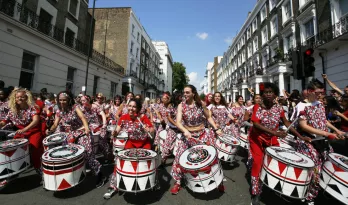Notting Hill Carnival 2023 in London
Europe's biggest street festival, the Notting Hill Carnival in London is a multicultural summer festival. Often compared to the Rio Carnival, the event attracts nearly 2 million people every year. Take advantage of this event to discover the British capital with our hop-on hop-off London bus tour.

What are the origins of the Notting Hill Carnival ?
The Notting Hill carnival was initiated in 1964 by black immigrants from the Caribbean, particularly Trinidad, where the Carnival tradition is very strong. It was then revived by a social worker, Rhaune Laslett, a Londoner of Native American and Russian descent. The first Notting Hill Carnival was held in 1966 in the streets of Notting Hill for local children.
Rhaune Laslett was worried about the tensions between the different ethnic groups in the area since the violent race-riots of the 1950s. She then conceived the idea of a festive event that would bring together and ease relations between the different communities, to the sound of percussion and the rhythms of soca, calypso, reggae, ragga and other musical genres broadcast through powerful sound systems.
The police authorities had a very negative vision of the event and tried to ban the Carnival. In the 1970s and early 1980s, the Carnival was a place of confrontation between the police and young immigrants. Since then, the situation has changed, and the British authorities are more likely to claim the Carnival as proof of the good integration of immigrants in England.
What is the Notting Hill Carnival?
The Notting Hill Carnival is a community-led event whose popularity has been increasing over the last 5 decades to become the wonderfully diverse and vibrant event it is today.
The Notting Hill Carnival is second to Brazil's Rio Carnival in size. It is now one of the globe's largest annual arts events. And it is considered to be the largest street event in Europe.
With the Windrush-generation (Windrush is the name of the boat on which West Indian immigrants arrived in the UK), the carnival finds its roots in Caribbean culture.
The festival features 5 aspects: masquerade (also called mas), steel pan bands, sound systems, soca, and calypso.
Dance to the sounds of sound systems and steel bands, wear your best colourful outfit and try jerk chicken or fresh coconut for a weekend of fun in the British capital. Feathers, sequins, headdresses, masks, wigs, body painting... Exuberant and colourful outfits are the order of the day during these two days of festivities. All nationalities are represented and some dance troupes wear traditional outfits.
During the long weekend, the streets of Notting Hill are transformed into a giant dance floor where visitors eager to party sway to the upbeat, danceable rhythms. Miles of colourful costumes, hundreds of Caribbean food stalls and thousands of visitors attend each year.
What is the programme of the Notting Hill Carnival 2023?
The Notting Hill Carnival usually takes place on August bank holiday weekend:
- The weekend before the last Monday in August;
- Sunday;
- Monday.
This year, the event will be held on August 27 and 28.
The parade is mainly made up of mobile sound systems, mas bands, semi-trailers carrying speakers that play music. A steelband competition will also be held in Emslie Horniman’s Pleasance Park.
The carnival parade (3 miles long) takes place in West London, around Chepstow Road, Great Western Road, Ladbroke Grove and Westbourne Park. Please note that access to Notting Hill is severely restricted during the carnival. Some tube stations are closed and bus routes are diverted. After 7pm, the party continues in the pubs and bars of the area.
How to get there?
Blue route: hop off at stop 33 Notting Hill Gate.
To continue your visit to London, check out our selection of activities to do with children during the summer holidays or the other festivals in London for this summer.